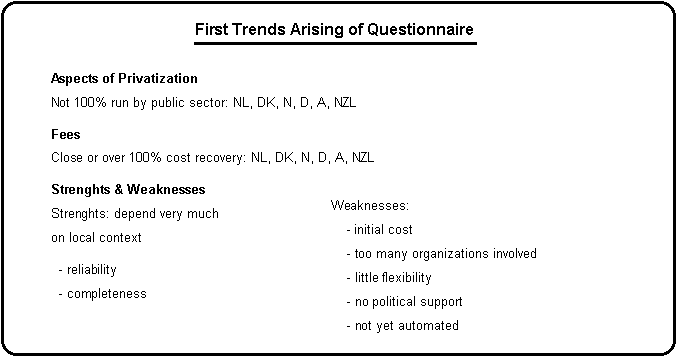
Jürg Kaufmann, Chairmann, Working Group 7.1
KAUFMANN CONSULTING, Switzerland
SUMMARY
This intermediate report describes the task and the progress of work of FIG Commission 7 Working Group 7.1.
As a first action the working group did send out a questionnaire to get an idea about the different national cadastral systems, their strenghts and weaknesses, the reforms going on and the trends for further development.
In parallel the chairman and the secretary of the working group undertook studies in OICRF in Apeldoorn and based on OICRF documents.
For the 'Seminar on Modern Cadastres and Cadastral Innovations' held in Delft during the annual meeting 1995 of Commission 7, six key statements on the 'Vision Cadastre 2014' were developed and presented. Together with the summary of the questionnair they were the basis of an extensive discussion within the working group. Several delegates made commments on the statements between the Delft and the following Budapest meeting 1996.
Based of this statements an investigation about the future demands for services of cadastral systems was made. The investigation showed, that cadastral systems should contain more information about public law restrictions of land rights to support a secure and sustainable development.
A second questionnaire to verify 'Cost Recovery and Privatisation Issues' was sent out in the beginning of the year 1997.
In these days the final report is to be prepared for the Brighton 1998 FIG-Congress.
Cadastre 2014 A report of the activities of the Commission 7 working group on modern cadasters
1. Task of the Working Group 7.1
The task of the Working Group 7.1 is it
• to study cadastral reform procedures as applied in developped countries
• take into consideration automation of the cadastre and the role of the cadastre as part of a larger land information system
• evalute trends in this field and produce a vision of where cadastral systems will be in the next 20 years
• show the means by which these changes will be achieved
• describe the technology to be used in implementing these changes.
2. Investigation on cadastral systems
To get an idea about the existing cadastral systems a questionnaire was sent out. The questions referred to the following issues:
Characterization of existing cadastre
Aspect of multipurpose cadastre
Aspects of privatization
Fees
Stengths and weaknesses of extisting system
Reforms
Trends.
The Summary of questionnaire responses shows the following:

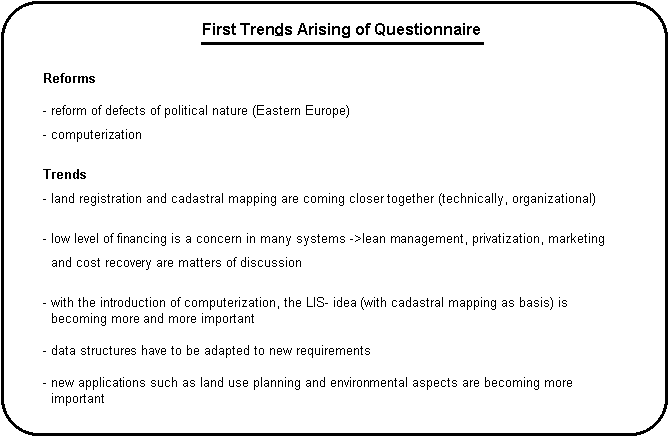
3. Development of the 'Statements on Cadastre 2014'
Based on OICRF documents and a discussion with Prof. J. Henssen at OICRF in Apeldoorn, a first basis for discussion within the working group was elaborated in the form of six Statements on Cadastre 2014. They were presented on the one day seminar on 'Modern Cadastres and Cadastral Innovation' in Delft, during the annual meeting 1995 of Commission 7. The results of the one day seminar have been published in a brochure 'Modern Cadastres and Cadastral Innovation, Proceedings of the One Day Seminar held during the Annual Meeting of Commission 7, May 16, 1995'. The proceedings may be found on Internet under http://www.sli.unimelb.cdu.au /fig7/annual reports. html
The statements:
Cadastre 2014 will show the complete legal situation of land! Privat and public rights and restrictions on land will be systematically documented!
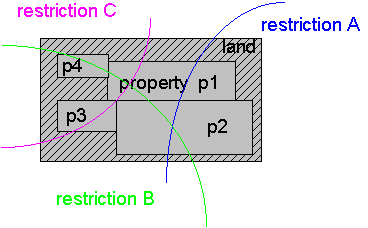
Comment:
Population of the world is growing. In the developped countries the consumption of land is increasing. Therefore the absolute control of the individual or of legal entities of land is more and more being restricted by public interests. To provide security of the land tenure all facts about land must be made obvious by the cadastral system in the future.
Consequences:
All the public rights and restrictions cannot be documented in relation to individual parcels. They are defined in relation to land and will have impacts on the parcels and the private rights referring to the parcels.
A new thematic model is therefore necessary:

Surveyors must consider more juridical aspects than they do now. The licences of the surveyors will have a higher importance than today.
Cadastre 2014 will be highly privatized! Public and private sector are working closely together!
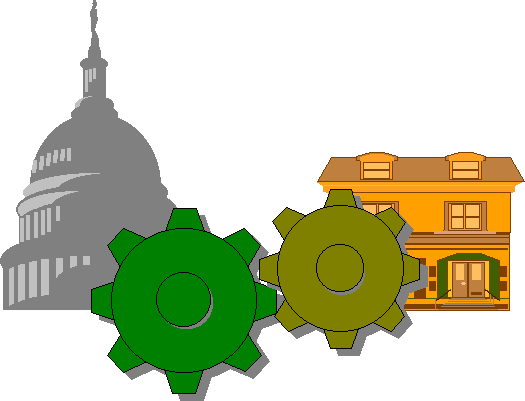
Comment:
Public systems tend to be less flexible and customer-oriented than private organizations. Free ecomonies demand flexibility in land markets, land planning and land utilization. Flexibility may be provided better by private institutions. For the necessary security a public engagement is indispensable.
Consequences:
The private sector will gain importance. The public sector will concentrate on supervision and control.
Cadastre 2014 will be cost recovering!
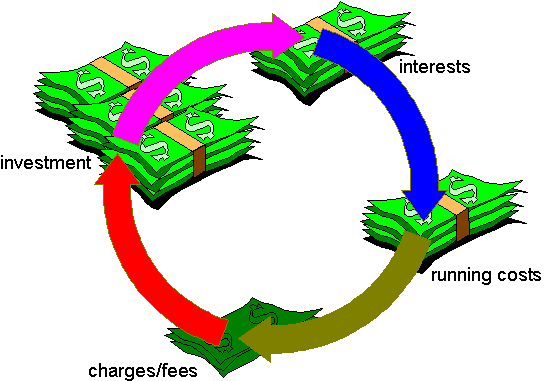
Comment:
Cadastral systems need big investments. But the the land documented and secured by the cadastre represents a multiple value of the investment in cadastre. The costs of the investment and the operation have to be payed back by those who have profit from cadastre.
Consequences:
Cost/benefit analysis will be a very important aspect of cadastre reform and implementation. Surveyors will have to deal more with economic questions in future.
The separation between 'maps' and 'registers' will be abolished!
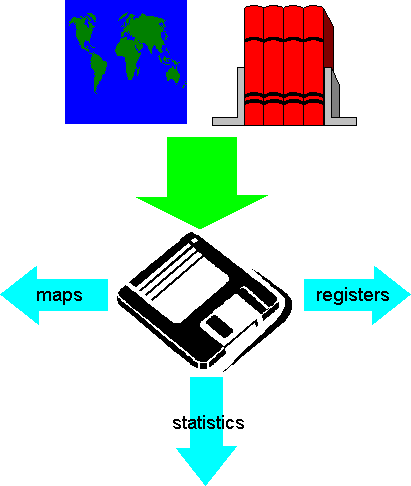
Comment:
The separation was necessary because the available technology - paper and pencil - did not allow an other solution. Modern technology offers new solutions.
Consequences:
The division of responsibilities between surveyor and solicitor in the domain of cadastre will be changed seriously
The 'cadastral mapping' will be dead! Long live modelling!
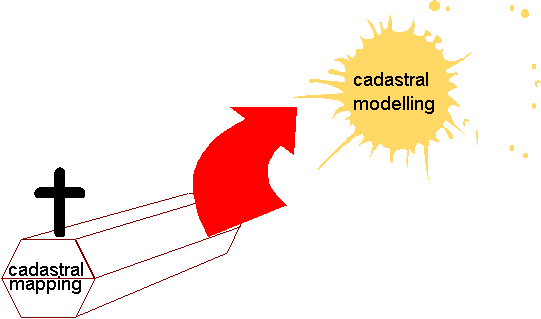
Comment:
Maps have always been models, but the available technology did not allow to use these models in a flexible way. So in mapping flexibility had to be brought in by different scales. Different scales had to be representated by different data models.
Modern technology allows the creation of maps of different scales and registers in different forms out of the same data model.
Consequences:
In 2014 there will be no draftmen and cartographers in the domain of cadastre.
'Paper and pencil - cadastre' will have gone!
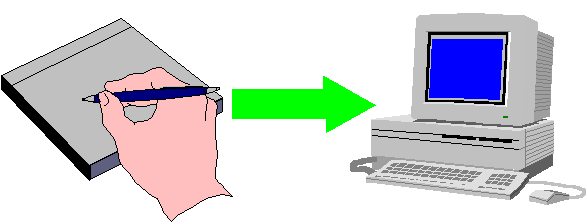
Comment:
Informatics technology will become the normal tool for cadastral work. Real low-cost approaches are only possible with this technology.
In developped countries only high tech solutions are able to render the services expected by the societies.
In developping counties and in countries in transition, reform and implementation of feasible cadastral systems must make use of the advantages of modern technology. Traditional methods will not provide the urgently necessary cadastral information in due time.
The whole world has to deal with similar problems of population, environment and reasonable land utilization. The solutions can only be found on the basis of the models of the existing situation.
Consequences:
The cadastre has to provide the basic model. Surveyors all over the world must be able to think in models and to apply modern technology to build up these models.
The discussion of the statements during the Delft and the following Budapest meeting of Commission 7 and the comments sent to the working group from all over the world showed, that
• the trends stated in the statements is confirmed and considered to be useful for the resolution of the problems of the different national societies
• the time to achieve changes will depend on the starting conditions and the political, economic and social situation of the different national cadastral systems
• in some developped countries there are projects going on, which show in the direction outlined by the statements
• the land administration procedures must be re-engineered to relieve them of the often complicated processes and multiplied components, which were necessary to make secure cadastral systems operated in a traditional manner
• there will be a need of mental changes within the profession to take advantage of a new cadastral approach
• to achieve new and better solutions, matching with the societies needs, political efforts are necessary besides professional development and training.
4. Investigation on services requested by users of the cadastre
In different countries cadastral reforms are going on. In Switzerland, the reform could be finished 1994 and the implementation was started.
Interviews with banks and the organizations of land and house owners brought the following results:
• the traditional land registry system cannot guarantee sufficient legal security of land property, because it is only considered with rights and charges based on civil law and neglects the use rights and restrictions imposed by public law
• the wish of land owners and banks is it, to have one single documentation system which can give a complete description of all legal conditions, effective for a piece of land
• the security of public-law rights and restrictions must be on the same level as the civil law information. A main obstacle for the creation of an integrated cadastral system is seen in the slow political decisionmaking procedures
• such modern, integrated cadastral systems may be operated by private organizations, under the condition, that a strong and competent governmental supervision exists and that the state law guarantees the rights and makes shure that restrictions are not misused
• cost recovery is seen as a mean to achieve fair financial charges for private and public users of the cadastral system. The interest of public authorities in cadastral information will be much higher in a system documenting the total legal conditions of land. Therefore costs for implementation and running such a cadastral system can be distributed to a bigger number of users
• the fusion of the geographic and the descriptive part of a cadastre is seen as possibility to improve effectiveness and efficiency of the cadastral system. The separation seems to create additional costs
• the possibility to have representations of parcels and their physical and legal attributes as an exploitation from a cadastral model on screens, is seen as a much better solution for land assessment work, than maps are
• work with computers instead of paper and pencil has become standard operational procedure in practically every domain. The users cannot see any reasons why cadastral systems should not be operated with the help of informatics technology.
5. Investigation on Cost Recovery and Privatization
The working group did elaborate a second questionnaire, which should give a much more precise and internationally comparable information about the cost and the cost recovery and privatization issue in the cadastral domain worldwide.
While writing this report the answers are not available. The first results will be presented at the Commission 7 Meeting 1997 in Penang (Malaysia) and complete results of this investigation will be part of the final report of the working group.
6. Further work of the Working Group
In the annual meeting 1997 of Commission 7 in Penang the first draft of the final report to be presented on the FIG 1998 Congress in Brighton was presented to the Working Group. The report describes besides a possible cadastral system and organization in 20 years the contribution of FIG, the national member organizations and the individual surveyors to support the creation of modern cadastral systems, serving the different societies for better and sustainable social and economic development. The main efforts must be made for the preparation of good political conditions and for the professional development.